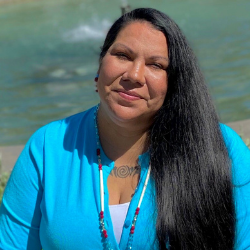
251 Days Into The Year, Today Is Native Women’s Equal Pay Day
Native Women’s Equal Pay Day 2021 (Native to be interchanged with Indigenous, Indian, Native American)
Guest blog by Marisa Page, she/her, Pawnee/Ponca/Comanche. Marisa Page is a citizen of the Pawnee Nation of Oklahoma and descends from the Ponca and Comanche tribes. She is currently a development officer with First Nations Development Institute.

It’s Cool to be Indian, Again, Again
“It’s cool to be Indian, again, again,” my mom said to me on the phone. My response was “right?” But is it cool? Do people really want the responsibilities of being Native American, woman or man? Or have they fallen in love with a mystical woman with long black hair, almond eyes, and copper skin? What about Native people makes it cool to be Native? Could it be the missing and murdered Indigenous women epidemic plaguing our country and Canada? The 6,509+ children found in mass graves at over 360 boarding schools? Or is it the mascot issue, where people cease to see us as real human beings? Oh, it must be the fact that Native women earn approximately $0.60 cents (this wage gap varies across Native communities and even hitting as low as $0.47) on the dollar of white, non-Hispanic men.
It’s cool to be Indian, again, again” my mother said. My response was ‘right?’
Native Women’s Equal Pay Day, 500 Years in the Making
This lack of earning potential is the result of over 500 years of genocide, forced assimilation, land theft, and inequities that happen when you are not viewed as a real human being. Indigenous peoples were the first ones on this continent, yet many “rights” that people had in the U.S. were not given to them. For instance, the right to vote was not given to Natives until 1924 when the Snyder Act admitted them as citizens.
So again, I pose the question, why is it cool to be Indian? What turquoise-colored glasses are non-Indians looking through when they consider the modern Indian experience? Can they romanticize Western landscape paintings while completely ignoring the present-day landscape in which Indians live and die?
Treaty Obligations and Such
According to new Census data the total number of people “identifying” as Native American increased by 2 million people since 2010, reaching more than 5.9 million in 2020. This is incredible, especially when there were as few as 500,000 (or less depending on who you ask) Native people in the U.S. at the turn of the 20th Century.
I give these numbers because I wonder what they mean for Native Americans living on reservations and the bureaucratic responsibilities and obligations the federal government has to federally recognized Indian tribes. And, what do they mean for tribal women? When such numbers are higher than the actual number of tribally enrolled citizens, assistance isn’t being allocated where it needs to go the most like – housing, tribal law enforcement, utility services, and other infrastructure needs.
The government responsibilities I speak of are not welfare. They are the obligation the government set forth through hundreds of treaties with different tribes, each treaty committing land resources and boundaries, peace, provisions in some cases, preservation of hunting and fishing rights, and protection. Yet the people the U.S. swore to protect continue to live in dire situations, often without clean running water on a hotbed of uranium waste. Or where they risk of having women taken and killed without a trace, despite being under the watchful eye of the federal government.
Cultural Richness
The truth is many Native women usually don’t dream of making a lot of money. Instead what’s important to us is being able to feed our families and pay our bills on time every month. Even when money is tight, Native women can carve out a meal for 20 people at a moment’s notice. We hold raffles and bake sales to get new moccasins for our children to dance in pow wows. We have the best chile stew and oven bread for each feast day. We make do. While affluent people count their riches in bank statements, Native women count their blessings in friends and family and health. We count ourselves lucky to be here, despite or in-spite-of the failed attempts of the U.S. government to wipe us out.
We are here for a reason! We are here to remind everyone that our beauty still lives on. It lives on through stories, it lives on through water protectors, agricultural practices, and Native food systems. It lives on through art and pottery, through beaded earrings and squash blossoms, and through song and dance. Most importantly it lives on through our children! And that’s all we want: An equal playing field for our children. We do not want the inequities that plagued Native people for over 500 years to perpetuate.
Until we as a society commit to ending centuries of racism and systematic oppression the cycle of poverty will continue, with the poor becoming poorer, and BIPOC women bearing the brunt of it. But with real change, the strength that has allowed Native women to persevere will allow our children to thrive.
Additional Reading
A Guide For Allies: Changing the Narrative About Native Americans, Indian Country 101, and other information on our anti-racism resources page.
The Women’s Foundation of Colorado is a nonpartisan organization. The opinions of guest bloggers are their own and do not necessarily reflect the opinions or positions of The Foundation.

